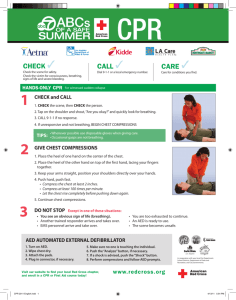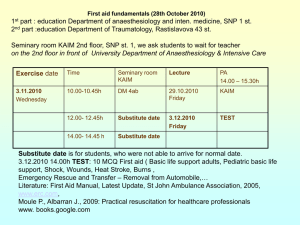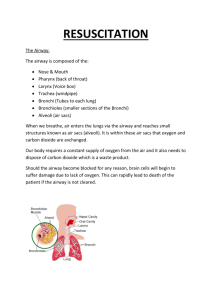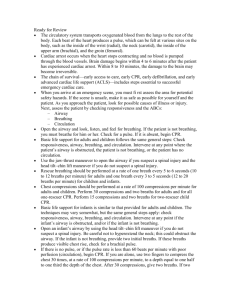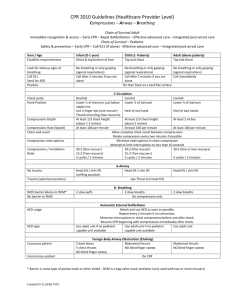Adult Choking and CPR Manual
advertisement
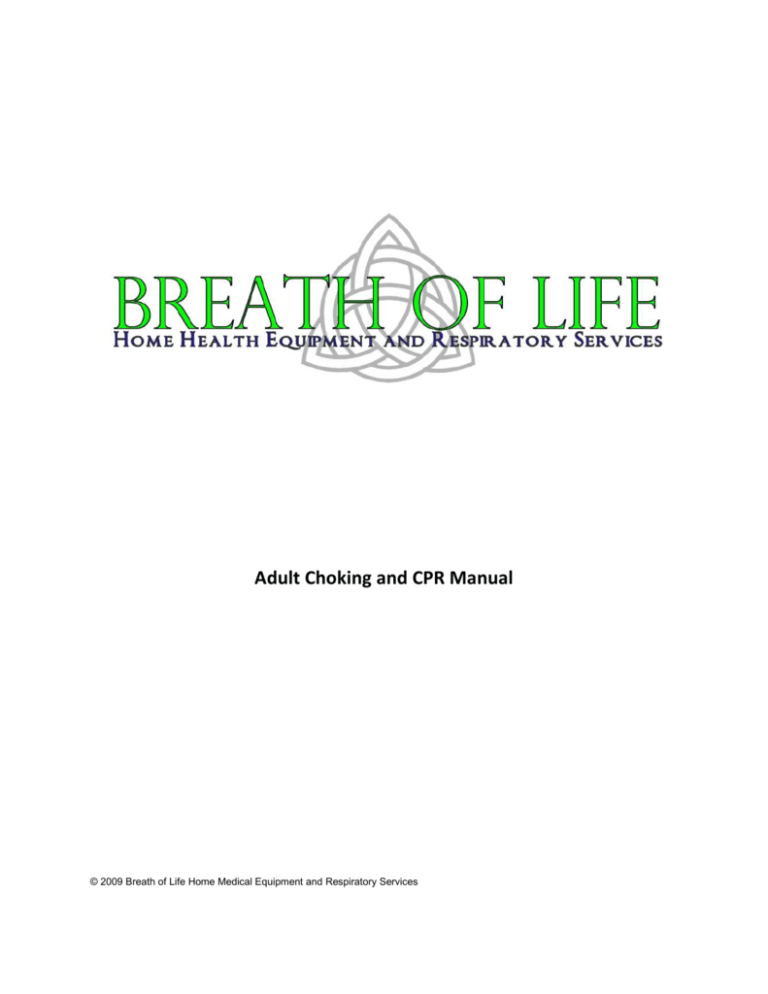
Adult Choking and CPR Manual © 2009 Breath of Life Home Medical Equipment and Respiratory Services CHOKING Description: Choking is the coughing spasm and sputtering that happen when liquids or solids get into the airway. (This is called aspiration) A cough reflex will clear the windpipe of liquid within 10 to 30 seconds. Complete blockage occurs when solid food or a foreign object becomes lodged in the voice box. If this happens you are unable to breathe, cry, or speak. The patient will be in a state of panic, and if the obstruction isn’t removed in 1 or 2 minutes, the patient will pass out. First Aid: 1. Call the rescue squad (911) immediately. In general, choking on liquids is temporary and harmless. Call 911 if the patient chokes on a liquid and turns blue, becomes limp, or passes out. 2. Encourage coughing: As long as the patient is breathing and coughing, do nothing except encourage him/her to cough the material up by him/her self. The main purpose of the cough reflex is to clear the windpipe. Don’t give the patient anything to drink because fluids may take up space needed for the passage of air. 3. Heimlich maneuver if the patient stops breathing: If the patient can’t breathe, cough or make a sound, proceed with high abdominal thrusts. Grasp the patient from behind, just below the lower ribs but above the waist, in bear hug fashion. Give a sudden upward jerk at a 45 degree angle to try to squeeze all the air out of the chest and dislodge the object from the windpipe. Quickly repeat this upward abdominal thrust 10 times in a rapid succession. If the patient is unable to stand and is too heavy for you to suspend from your arms, lay him/her on his/her back on the floor. Put your hands on both sides of the abdomen, just below the ribs, and apply sudden, strong bursts of upward pressure. 4.Clearing the airway of an unconscious person: Lower the person on his or her back onto the floor. Clear the airway. If there is a visible blockage at the back of the throat or high in the throat, reach a finger into the mouth and sweep out the cause of the blockage. Be careful not to push the food or object deeper into the airway, which can happen easily in young children. Begin cardiopulmonary resuscitation (CPR) if the object remains lodged and the person doesn't respond after you take the above measures. The chest compressions used in CPR may dislodge the object. Remember to recheck the mouth periodically. 5.Resuscitation if the patient passes out from choking: The rescue squad should be on its way. Quickly open the patient’s mouth and look inside with a light to see if there is an object that can be removed with your fingers or tweezers (usually there is not). DO NOT put your fingers into the mouth unless you already see the object. Doing this blindly can wedge an object deeper into the voice box (larynx). If you know how, begin mouth-to-mouth resuscitation. Air can usually be forced past the foreign object. If mouth-to-mouth breathing doesn’t move the chest, repeat the abdominal thrusts. Prevention: Choking can be life-threatening, so try to prevent it from happening again by not giving young children foods or small objects that are most likely to cause choking. Foods that are most likely to cause choking are nuts of any kind, sunflower seeds, orange seeds, cherry pits, watermelon seeds, gum, hard candies, popcorn, raw carrots, raw peas, raw celery, and tough meats. Written by B.D Schmitt, M. D. author of “Your Child’s Health,” Bantam Books. Published by Clinical reference Systems, a division of HBO & Company LAY PERSON CPR ON ADULTS What is CPR? CPR is also called cardiopulmonary resuscitation. CPR is used when a victim is found not breathing and his/her heart has stopped beating. CPR may be able to start their breathing and heart beating again. If CPR is started early and done correctly, you may be able to save a victim from dying. Rescue breathing is done whan a child is not breat breathing hing but the heart is still beating. By breathing for the child, you may deep him/her alive. Rescue breathing may be done by itself, or with chest compressions. When rescue breathing and CPR are done together, it is called CPR. What is the cardiopulmona cardiopulmonary system? The heart, blood vessels, and lungs make up the cardiopulmonary systems. The heart is in the middle of the chest between the spine (backbone) and the sternum (breastbone). The two lungs are inside to the right and left sides of the chest. The jjob of the heart is to pump blood to the lungs and then out to the body. The lungs put oxygen into the blood to feed muscles, bones and tissues of the body. Blood vessels called arteries and veins carry the blood throughout the body. Without oxygen, organs, muscles, bones and tissues will die within a short time. Why would an adult need CPR? The main reasons that a adult may stop breathing and his/her heart stop beating are the following • Blocked airway – This could be by the tongue or food • Cardiac arrest – The heart stops • Drowning • Infection • Injuries – Such as from falling or burns • Pneumonia • Head trauma What do I do first when I find an adult that looks to be not breathing, or heart is not beating? • • • • Make sure the area is safe for you to enter Find out if the patient is OK. Do this by tapping the patinet. Shout very loudly “Are you OK?” If the patient does not respond, send someone to call 911 for help. If you are alone, begin the steps of CPR and do them for 1 minute. After 1 minute, call 911 yourself. The sooner caregivers arrive, the greater the chance the child will live. Stay on the phone with the 911 operator until you are told to hang up. Make sure the 911 operator is told the following important information: Where you are, including the address and the cross streets or roads. This will help EMS find you quickly The telephone number from where you are calling What happened, such as the patient stopped breathing If there are other injuries that you can see, such as bleeding from the head What help has been given to the sick or injured patient so far How do I give an adult rescue breathing or CPR? • By following the “ABC’s”, you can remember the steps to use when giving CPR. The letter A stands for airway, B stands for breathing, and C stands for circulation. Airway: • • • If you suspect broken arms, legs or back do not move the patient. Moving a patient with a broken neck or back could cause them to become paralyzed. If you don’t see other injuries, turn the patient onto their back while supporting the head. The patient should be face up on a firm, flat surface. The patient’s head must be on the same level or lower than his/her heart. Check if the patient has an open airway. Kneel beside the patient and open the airway by gently tilting the head back and lifting the chin. Never lift under a patient’s neck to tilt their head. Look into the patient’s mouth and check if anything is blocking the airway. This may be food or a small toy. If you see something, scoop it out with your finger. If you thing the patient may have a head or neck injury, lift the jaw forward instead of tilting the head. This should open the airway. Breathing: • • • • • Check if the patient is breathing. Look at the patient’s chest and belly to see if it goes up and down with breathing. Take 5 or 10 seconds to look, listen and feel, even if you are nervous and anxious. Feel for breathing by putting your face close to the patinet’s face. Put your hand lightly on the patinet’s chest to feel for chest movement. Make sure the airway is open, and listen and feel for air coming out of the mouth or nose. If the patient is breathing on his own, and there are no injuries to the head or neck, turn the patient on his/her side. This is called the recovery position and is used to prevent choking if the patient throws up. Wait for EMS help to arrive. If there is no breathing, you must breathe for the patient. This is called rescue breathing. Keep the airway open my having the head tilted and the chin slightly lifted by keeping one hand on the patient’s forehead. Gently pinch the child’s nose with one hand. This keeps air from escaping from the nose. Take a deep breath for yourself and place your lips over the mouth of the patient. Try to make an airtight seal with your mouth. Give two slow breaths (1-1/2 seconds per breath). Make sure you take a breath for yourself after giving each breath. If you don’t see the patient’s chest rising with each breath, the airway may not be open. Gently move the patient’s head to open the airway and try again to breathe for him. Any time you see that air is not going in (the chest is not rising with your breaths), check for something that may be blocking the airway. If you see something, scoop it out with your finger. Circulation: • • • • Check for signs of blood and oxygen circulation in the patient. Signs of circulation are breathing (not gasping), coughing or movement after you do rescue breathing. Put your ear next to the patient’s mouth and look, listen and feel for breathing. Look for other movement from the patient. If the patient is not breathing, coughing, or moving, you should immediately begin chest compressions. Chest compressions are when you put pressure on and off the chest with your hand. These compressions press the heart between the spine (backbone) and sternum (breastbone). This forces blood from the heart and into the rest of the body. To find the right place to do compressions, put the fingers of the hand furthest away from the head of the child on the child’s lower rib cage. Move the fingers up the rib cage to the place where the ribs meet in the middle of the chest. This is the sternum. Place the heel of one of your hands on the sternum right above where your fingers just were. Your hand should be on the lower part of the sternum. Correct hand positioning for chest compressions is important because ribs connect to the sternum. Incorrect hand placement can break the ribs during compressions. • • • • • • • Getting up on your knees, position your body right over the patient, not to the side. With the heel of one hand, press straight down on the patient’s chest, 1 inch to 11/2 inches in depth. This should be about one third the depth of the patient’s chest. Try to keep your arm straight when doing chest compressions. Look down at your hand. You should give compressions at a rate of 100 per minute. Do the compressions in a smooth, equal way. Do not lift your hand off the patient’s chest between compressions. But do not leave pressure on the chest between compressions. This lets the heart fill back up with blood. Keep your other hand on the patient’s forehead. After giving 30 compressions, make sure the airway is open and pinch the patient’s nose. Give two slow rescue breaths to the patient. Continue with cycles of 30 compressions followed by two breaths. Check the patient’s circulation after one minute of CPR. Check for normal breathing, coughing or movement. With your ear next to the patient’s mouth, look, listen and feel for breathing. If no one has called 911, if the patient is not breathing, coughing, or moving continue cycles of 30 compressions, followed by two breaths. Checking for breathing and signs of circulation every few minutes until help arrives. If there are signs of circulation, but you do not see or feel breathing, do rescue breathing as outlined in the steps above. You should give 1 breath every 3 seconds when you do rescue breathing. In this case, do not do chest compressions, but continue breathing for the patient. If the patient is breathing normally, moving, or coughing, this means they are breathing and their heart is beating. If there are no signs of head or neck injury, turn the patient on to his side and stay with him. Watch him carefully in case he stops breathing as you wait for help to arrive. If the patient looks like he/she is getting worse, follow the ABC’s as described above. MANUAL VENTILATION Anytime you have a patient with a tracheostomy or compromised airway you may need to manually ventilate the patient. When performing this procedure, keep in mind these important steps: Always watch for CHEST RISE and FALL Time the breaths that you are delivering with the spontaneous breaths of the patient. This will help eliminate any discomfort felt by the patient and any difficulty you may have with providing the patient with a breath. Do not hyperventilate the patient by bagging too fast. Hyperventilation will blow off the child’s CO2 which may cause them to faint When using a manual resuscitator it should be connected to 100% oxygen If the patient’s lips and nail beds are turning blue (cyanotic) while you are manually ventilating, make sure you are connected to the oxygen. If the patient is on CPAP or has any PEEP with the ventilator, make sure that it is also on the manual resuscitator and appropriately set.

